1993 CHEVROLET BLAZER service schedule
[x] Cancel search: service schedulePage 299 of 386
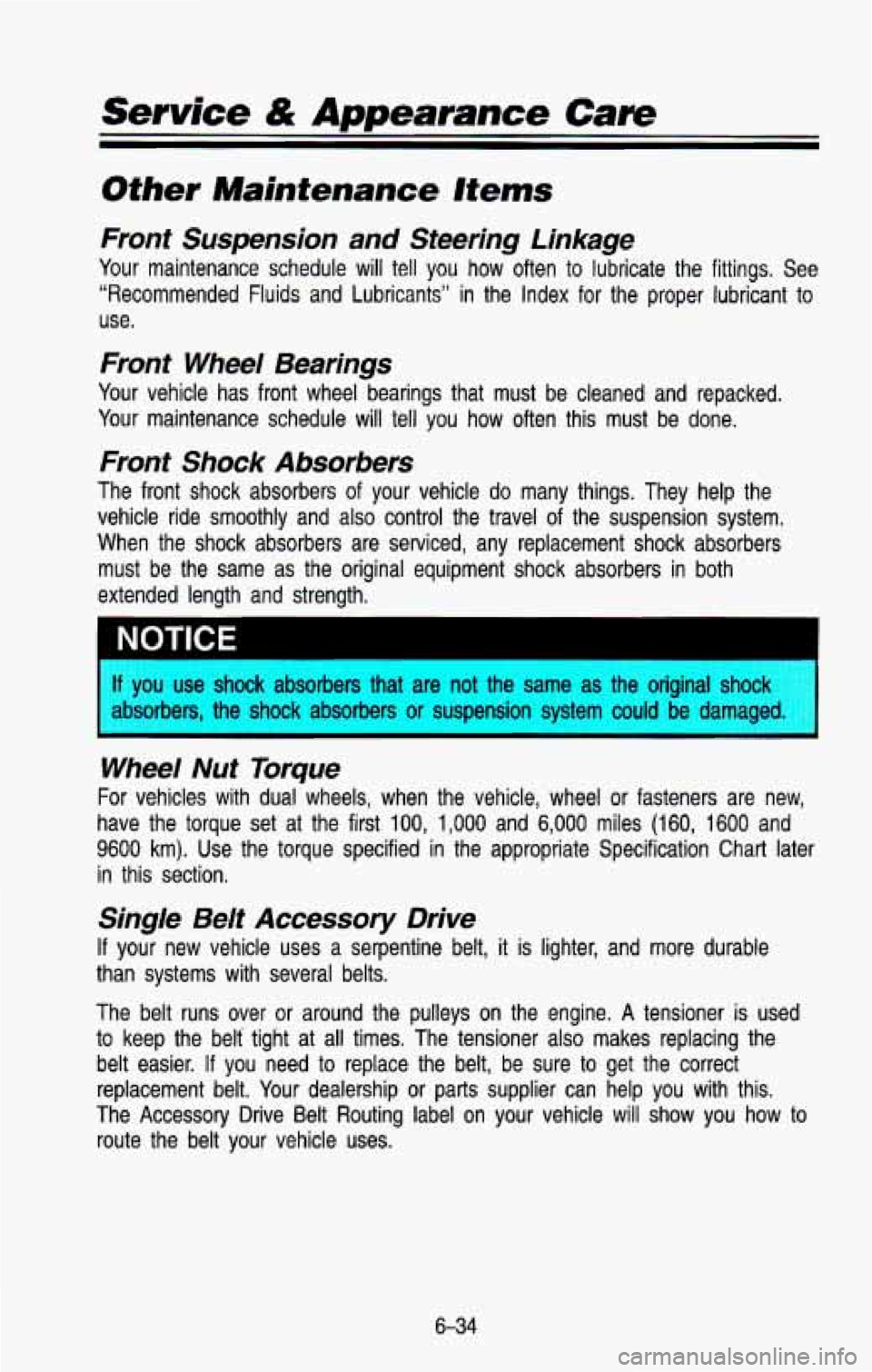
Service & Appearance Care
Front Suspension and Steering Linkage
Your maintenance schedule will tell you how often to lubricate the fittings. See
“Recommended Fluids and Lubricants” in the Index for the \
proper lubricant to
use.
Front Wheel Bearings
Your vehicle has front wheel bearings that must be cleaned and repa\
cked.
Your maintenance schedule will
tell you how often this must be done.
Front Shock Absorbers
The front shock absorbers of your vehicle do many things. They help the
vehicle ride smoothly and also control the travel of the suspension system.
When the shock absorbers are serviced, any replacement shock ab\
sorbers must be the same as the original equipment shock absorbers in \
both
extended length and strength.
Wheel Nut Torque
For vehicles with dual wheels, when the vehicle, wheel or fast\
eners are new,
have the torque set at the first
100, 1,000 and 6,000 miles (160, 1600 and
9600 km). Use the torque specified in the appropriate Specification \
Chart later
in this section.
Single Belt Accessory Drive
If your new vehicle uses a serpentine belt, it is lighter, and more durable
than systems with several belts.
The belt runs over or around the pulleys on the engine.
A tensioner is used
to keep the belt tight at all times. The tensioner also makes replacing the
belt easier. If you need
to replace the belt, be sure to get the correct
replacement belt. Your dealership or parts supplier can help you with this.
The Accessory Drive Belt Routing label on your vehicle will sh\
ow you how to route the belt your vehicle uses.
6-34
Page 301 of 386
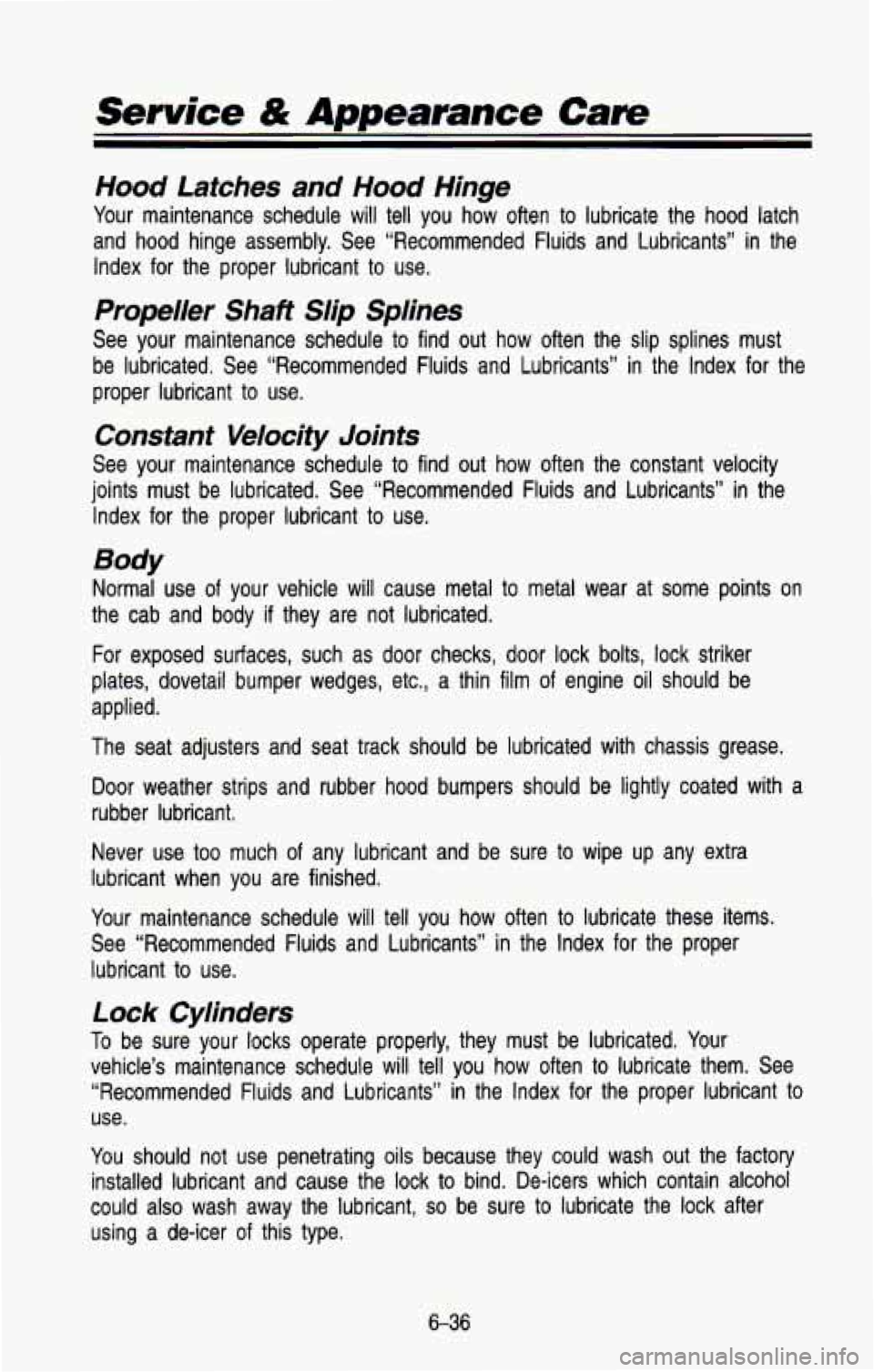
Service & Appearance Care
Hood Laiches and Hood Hinge
Your maintenance schedule will tell you how often to lubricate the hood latch
and hood hinge assembly. See “Recommended Fluids and Lubrican\
ts” in the
Index for the proper lubricant to use.
Propeller Shaft Slip Splines
See your maintenance schedule to find out how often the slip \
splines must
be lubricated, See “Recommended Fluids and Lubricants” in the Index for the
proper lubricant to use.
Constant Velocity Joints
See your maintenance schedule to find out how often the consta\
nt velocity
joints must be lubricated. See “Recommended Fluids and Lubricants”\
in the
Index for the proper lubricant to use.
Body
Normal use of your vehicle will cause metal to metal wear at some points on
the cab and body
if they are not lubricated.
For exposed surfaces, such as door checks, door lock bolts, lo\
ck striker
plates, dovetail bumper wedges, etc., a thin film of engine oil should be
applied.
The seat adjusters and seat track should be lubricated with ch\
assis grease, Door weather strips and rubber hood bumpers should be lightly \
coated with a
rubber lubricant.
Never use too much of any lubricant and be sure to wipe up any extra
lubricant when you are finished.
Your maintenance schedule will tell you how often to lubricate these items.
See “Recommended Fluids and Lubricants” in the Index
for the proper
lubricant to use.
Lock Cylinders
To be sure your locks operate properly, they must be lubricated, Your
vehicle’s maintenance schedule will tell you how often
to lubricate them. See
“Recommended Fluids and Lubricants”
in the Index for the proper lubricant to
use.
You should not use penetrating oils because they could wash out the factory
installed lubricant and cause the lock to bind. De-icers which contain alcohol
could also wash away the lubricant,
so be sure to lubricate the lock after
using a de-icer
of this type.
6-36
Page 317 of 386
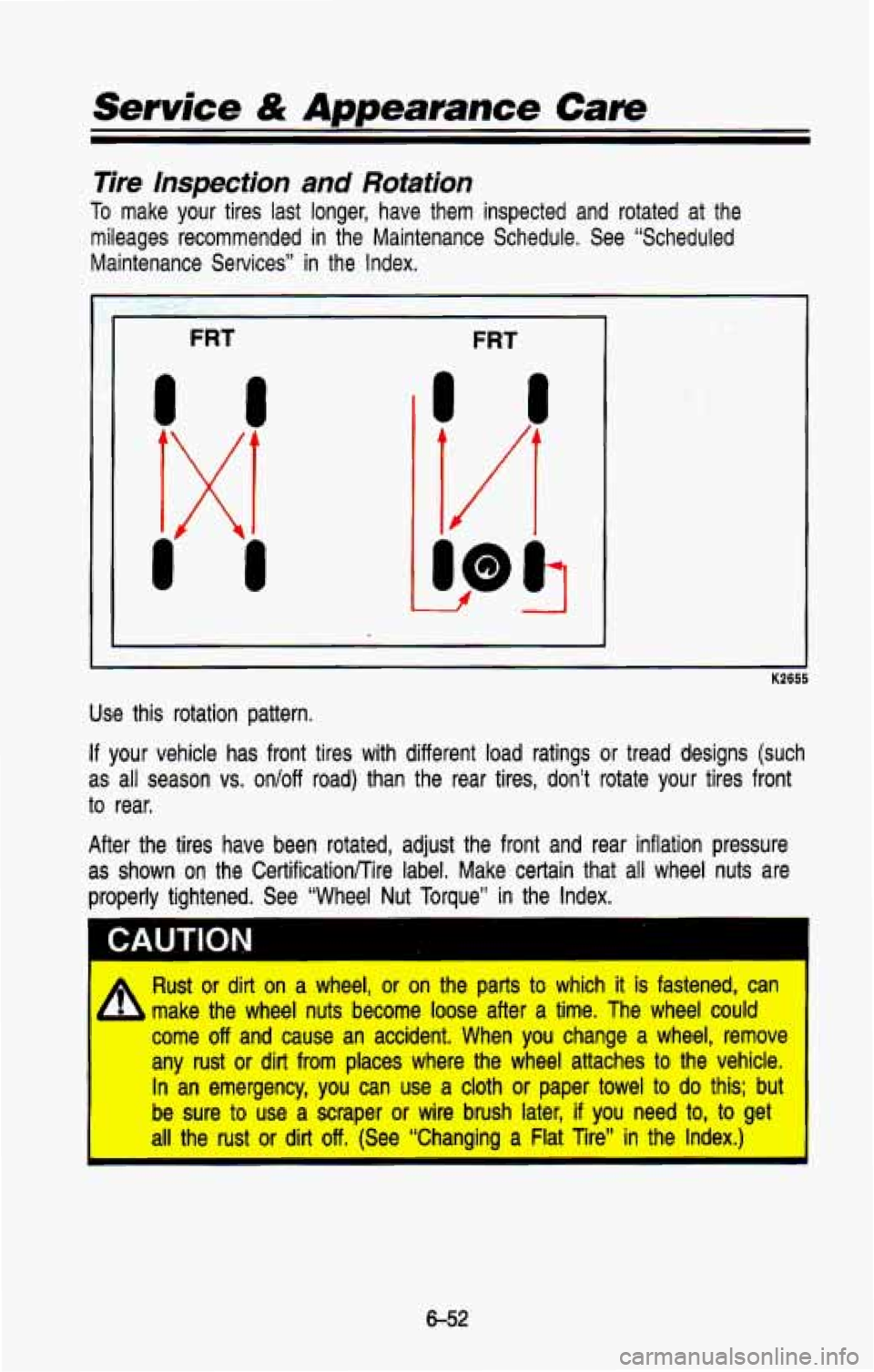
Service & Appearance Care
Tire lnspecfion and Rotation
To make your tires last longer, have them inspected and rotated at the
mileages recommended in the Maintenance Schedule. See “Scheduled
Maintenance Services” in the Index.
FRT FRT
L
I I
K2655
Use this rotation pattern,
If your vehicle has front tires with different load ratings or tr\
ead designs (such
as all season vs. on/off road) than the rear tires, don’t rotate \
your tires front
to rear,
After the tires have been rotated, adjust the front and rear \
inflation pressure
as shown on the CertificationRire label. Make certain that all \
wheel nuts are
properly tightened.
See “Wheel Nut Torque” in the Index.
1 CAUTION
Rust or dirt on a wheel, or on the parts to which it is fastened, can
make the wheel nuts become loose after a time. The wheel could
come
off and cause an accident. When you change a wheel, remove
any rust or dirt from places where the wheel attaches
to the vehicle.
In an emergency, you can use a cloth or paper towel to
do this; but
be sure to use a scraper or wire brush later, if you need to, to get
I
I all the rust or dirt off. (See ‘Changing a Flat Tire” in the Index.) I
&52
Page 338 of 386
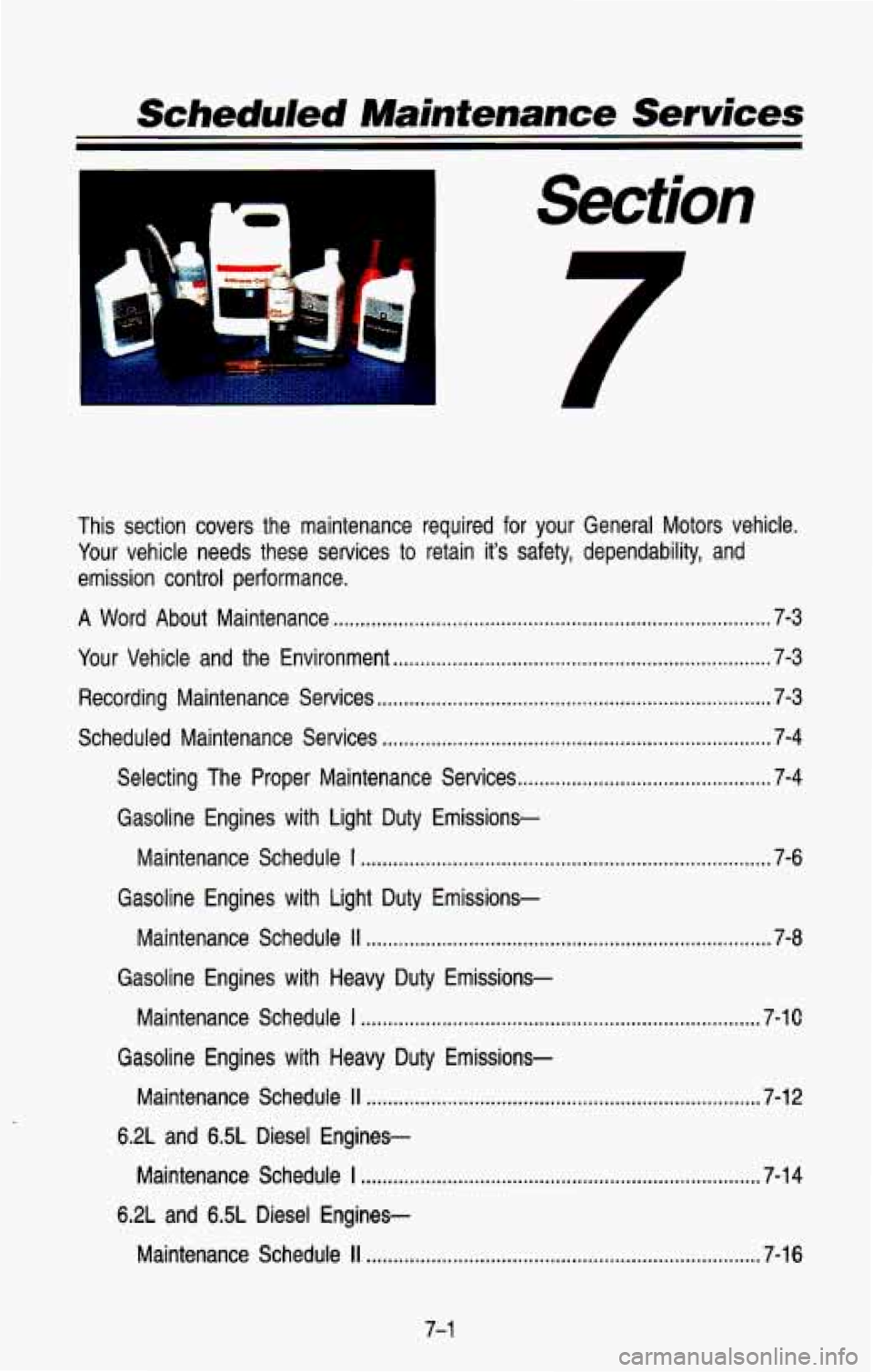
Scheduled Mainfenance Services
Section
This section covers the maintenance required for your General Motors \
vehicle.
Your vehicle needs these services
to retain it’s safety, dependability, and
emission control performance.
A Word About Maintenance ........................................................................\
......... 7-3
Your Vehicle and the Environment
...................................................................... 7-3
Recording Maintenance Services
........................................................................\
. 7-3
Scheduled Maintenance Services
........................................................................\
7-4
Selecting The Proper Maintenance Services ............................................... 7-4
Gasoline Engines with Light Duty Emissions- Maintenance Schedule
I ........................................................................\
.... 7-6
Gasoline Engines with Light Duty Emissions- Maintenance Schedule
II ........................................................................\
... 7-8
Gasoline Engines with Heavy Duty Emissions- Maintenance Schedule
I ........................................................................\
.. 7-1 C
Gasoline Engines with Heavy Duty Emissions- Maintenance Schedule
II ........................................................................\
. 7-1 2
6.2L and 6.5L Diesel Engines-
Maintenance Schedule
I ........................................................................\
.. 7-1 4
6.2L and 6.5L Diesel Engines- Maintenance Schedule
II ........................................................................\
. 7-1 6
7-1
Page 339 of 386
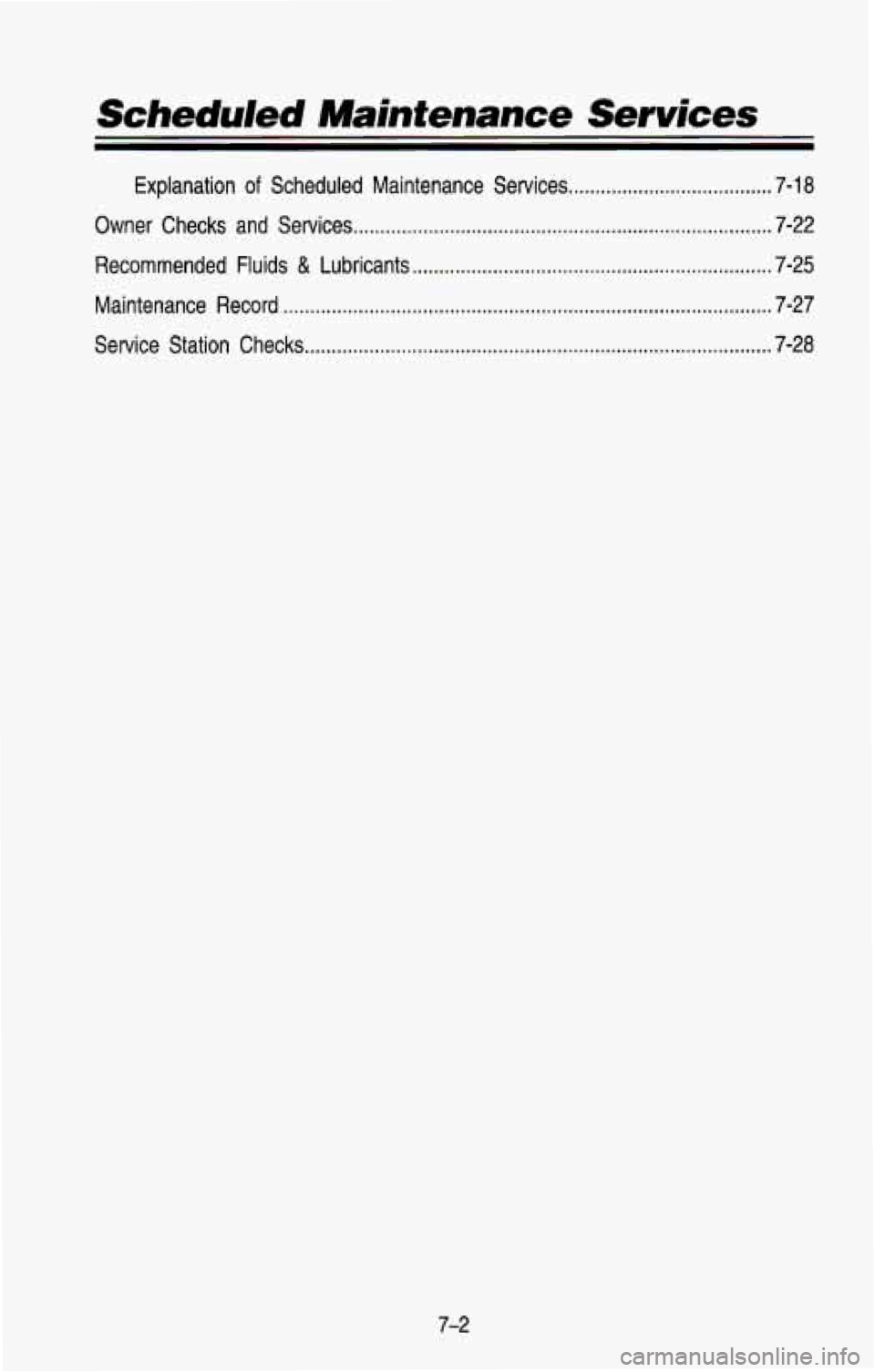
Scheduled Mainfenance Services
Explanation of Scheduled Maintenance Services ...................................... 7-18
Owner Checks and Services
........................................................................\
...... 7-22
Recommended Fluids
& Lubricants ................................................................... 7-25
Maintenance Record
........................................................................\
................... 7-27
Service Station Checks
........................................................................\
............... 7-28
7-2
Page 340 of 386
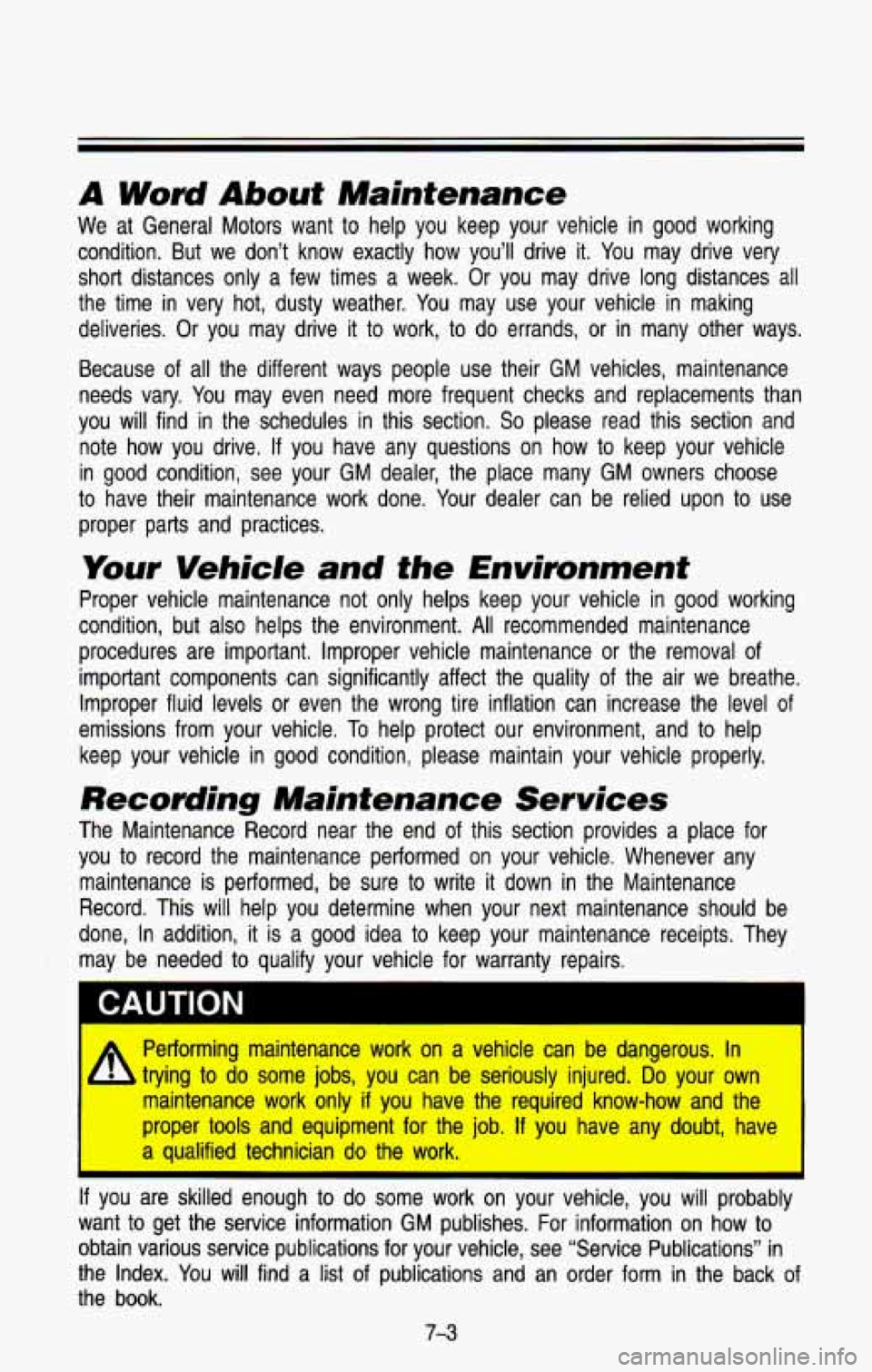
A Word About Maintenance
We at General Motors want to help you keep your vehicle in good working
condition. But we don’t know exactly how you’ll drive it. You may drive very
short distances only a few times a week. Or you may drive long distances
all
the time in very hot, dusty weather. You may use your vehicle in making
deliveries. Or you may drive it to work, to do errands, or in many other ways.
Because of all the different ways people use their GM vehicles, maintenance
needs vary. You may even need more frequent checks and replacements than
you will find in the schedules in this section. So please rea\
d this section and
note how you drive. If you have any questions on how to keep your vehicle
in good condition, see your
GM dealer, the place many GM owners choose
to have their maintenance work done. Your dealer can be relied upon to use
proper parts and practices.
Your Vehicle and the Environment
Proper vehicle maintenance not only helps keep your vehicle in \
good working
condition, but also helps the environment.
All recommended maintenance
procedures are important. Improper vehicle maintenance or the re\
moval of
important components can significantly affect the quality
of the air we breathe.
Improper fluid levels or even the wrong
tire inflation can increase the level of
emissions from your vehicle.
To help protect our environment, and to help
keep your vehicle in good condition, please maintain your vehicle properly.
Recording Maintenance Services
The Maintenance Record near the end of this section provides a place for
you to record the maintenance performed on your vehicle. Whenever any
maintenance is performed, be sure to write
it down in the Maintenance
Record. This will help you determine when your next maintenance\
should be
done, In addition,
it is a good idea to keep your maintenance receipts. They
may be needed to qualify your vehicle for warranty repairs.
rn I CAUTION
I A Performing maintenance work on a vehicle can be dangerous. In
~
If you are skilled enough to do some work on your vehicle, you will probably
want to get the service information
GM publishes. For information on how to
obtain various service publications for your vehicle, see “Se\
rvice Publications” in
the Index. You will find a list of publications and an order form in the back of
the book.
L trying to do some jobs, you can be seriously injured. Do your own
maintenance
work only if you have the required know-how and the
proper tools and equipment for the job. If you have any doubt, have
l a qualified technician do the work.
Page 341 of 386

Scheduled Maintenance Services
Scheduled Maintenance Services
This part tells you the maintenance services that you should h\
ave done and
the times you should schedule them. Your
GM dealer knows your vehicle best
and wants you to be happy with it.
If you go to your dealer for your service
needs, you’ll know that GM-trained and supported service peop\
le will perform
the work using genuine GM parts.
These schedules are for vehicles that:
carry passengers and cargo within the recommended limits. You will find
these limits on your vehicle’s Certification Label. See “L\
oading Your
Vehicle” in the Index.
are driven on regular road surfaces, and within legal driving \
limits.
are driven off-road in the recommended manner. See the index Under
use the recommended fuel. See “Fuel” in the Index.
“Off Road Driving With Your Four Wheel Drive Vehicle.”
Selecting The Proper Maintenance Services
To find the proper maintenance schedule for your vehicle, you must know\
two
things. What engine your vehicle has, and how you use your ve\
hicle. Your
engine type will tell you which chart to use, and your driving conditions will
tell you which schedule to use. The charts are found later in this section.
Selecting the Proper Maintenance Chart
Your engine type (Gasoline or Diesel) and its emissions classification (L\
ight
Duty
or Heavy Duty Emissions) will tell you which maintenance chart to use.
Find your Vehicle Identification Number (VIN), and
look at the eighth character
to see what your engine code is. Then use the following Engine Emissions
Classifications table
to find your emissions classification.
Your VIN is on the plate on the top left corner of your instrument panel,
the Certification Label and on the Service Parts Identification Label. See
“Vehicle Identification Number” in the Index.
Certification Label to see what your Gross Vehicle Weight Rating
(GVWR) is. See “Loading Your Vehicle” in the Index.
If your engine has more than one emissions classification, look at your
7-4
Page 343 of 386

Scheduled Maintenance Services
GASOLINE ENGINES WITH LIGHT DUTY EMISSIONS-
FOOTNOTES:
**See “Explanation of Scheduled Maintenance Services” in this section.
*An
Emission Control Service
tTo determine the emissions classification of your engine refer to “Selecting the
Proper Maintenance Chart” in this section.
TO337
7-6